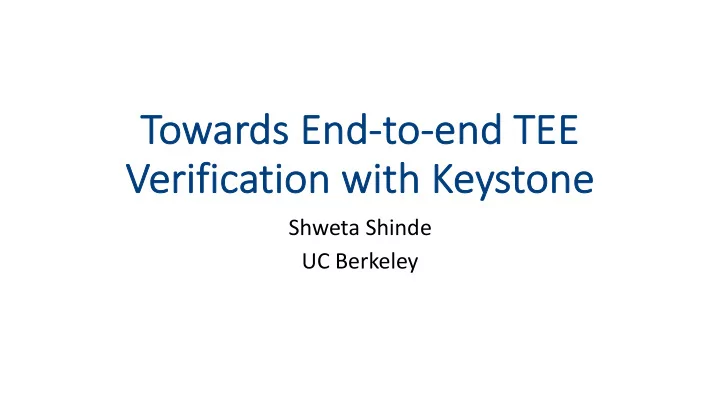

To Towards End-to to-en end TEE Ve Verification with Keystone Shweta Shinde UC Berkeley
TEEs reduce the Trusted Computing Base Web Other Server Apps Operating Enclave Systems RAM Ring 3 10 MLOC OS / Hypervisor CVEs in Linux [CVE-DB] Ring 0 - 2 Enclave Memory Hypervisor Trustworthy Trusted Hardware Untrusted 150 KLOC CVEs in Xen [CVE-DB] 2
We strive for lower TCB for TEEs Makes them amenable to verification 3
What is the estimated Keystone TCB? Untrusted U-mode Lower User process Enclave S-mode OS Privilege Keystone Runtime Hypervisor M-mode Security Monitor Root of Trust Higher Around 10 KLoC Trusted 4
Can we do an end-to-end verification of TEEs? Eapp Logic Some Open Challenges Untrusted and enclave APIs • Verify-then-trust model SM, RT, SDK libraries • What is the TCB of this stack? Attestation • What are the specifications of each layer? Secure Boot • Under which threat model do the PMP spec and usage properties hold true? • Can the upper layer verify & trust the RISC-V chip components properties guaranteed by lower layers? SOC design & manufacturing 5
Ongoing Verification Efforts for TEEs 6
Keystone Design Makes Verification Easier • The modular design allows to reduce TCB per use-case • Each component has well-defined APIs and properties by design • Existing components can be independently verified • Benefit from existing verification efforts in the TEE space • Easy to verify new components before integration 7
Keystone Design Makes Verification Easier • Three on-going efforts which demonstrate this: • Extending Trusted Abstract Platform (TAP) to Keystone : Formalization of idealized enclave platforms along with a parameterized adversary • BesFS : Mechanized Proof of a Iago-Safe Filesystem for Enclaves • Friscy : Formal verification PMP implementation and use in the security monitor PMP Implementation & Use Iago-Safe Filesytem API 8
Ef Effort #1 BesFS: Mechanized Proof of a Iago- Safe Filesystem for Enclaves • Iago Attacks: “Manipulate system call return values for arbitrary computation at the malicious kernel’s behest” [ASPLOS’13] Transformation Enclave Original Haven / Scone / Application Application Asylo / Panoply/ Intel SGX SDK / Keystone Syscall Untrusted API API Ad-hoc Checks Benign OS Untrusted OS Best-effort 9
Iago Attacks via the Filesystem API • (A1) File Content Manipulation Maps same page to multiple files/ parts of a file • • (A2) Paths & File Descriptor Mismatch Returns wrong file id, opens wrong file • • (A3) Size Mismatch Under or over write/reads • • (A4) Error Code Manipulation Returns success without doing the operation • Why do we need a verified file system interface? Because checks are incomplete 10
BesFS State Properties • All the file and directory paths are unique, there are no circular paths in the file system • All open file IDs have to be registered in O • All open file IDs have unique entries • No overlaps between addresses & one-to-one mapping from virtual address to content • Current cursor position can only take values between 0 and EOF 11
BesFS Transition Properties 12
BesFS Proof • State Transition Safety . Given a good state S satisfying pre-conditions pre i , then if we execute f i to reach state Sʹ, then Sʹ is always a good state and relation between S and Sʹ is valid according to the transition relation τ i : • Sequential Composition Safety . Given a good initial state S 0 subject to a sequence of transitions τ m1 , . . . , τ mn always produces a good final state S n 13
BesFS Summary of Results • TCB: 3676 LOC Coq, 1.5K LOC in C • Do Proofs Help in Eliminating Bugs? – Seek Specification Bug – Intel SGX SDK Bugs • if pos < size • enclave’s stack is corruption for large sizes – Write Implementation Bug – Error Code Bugs • Variable scope overlaps • 7 distinct functions where error codes were incorrect 14
Effort #2 Extending Trusted Abstract Platform Ef (TAP) to Keystone • Prove secure remote execution for Keystone security monitor • SRE decomposed into separate proofs on integrity, confidentiality, and measurement • Proofs verified under various parameterizations of the adversary 15
Effort #3 FRISCY: Formal Verification of PMP Ef Implementation & Use in the Security Monitor • Goal: Verify the Keystone memory isolation implementation in the SM • Extract the PMP Model from Rocket Chip SOC implementation • Prove PMP properties and use these properties to further check SM implementation SoC Configuration RISC-V RTL FIRRTL for PMP PMPChecker UCLID5 Model 16
A long way to go until all the layers of the TEE are fully verified 17
End-to-end Verified TEE Ecosystem Eapp Logic ü A well-defined adversary model, Untrusted and enclave APIs specifications of each layer, properties expected at the layer interfaces SM, RT, SDK libraries ü Standard way of composing and Attestation customizing components while retaining verification guarantees Secure Boot PMP spec and usage Let’s work together towards RISC-V chip components this grand vision! SOC design & manufacturing 18
Thank You! Shweta Shinde shwetas@berkeley.edu 20
Recommend
More recommend